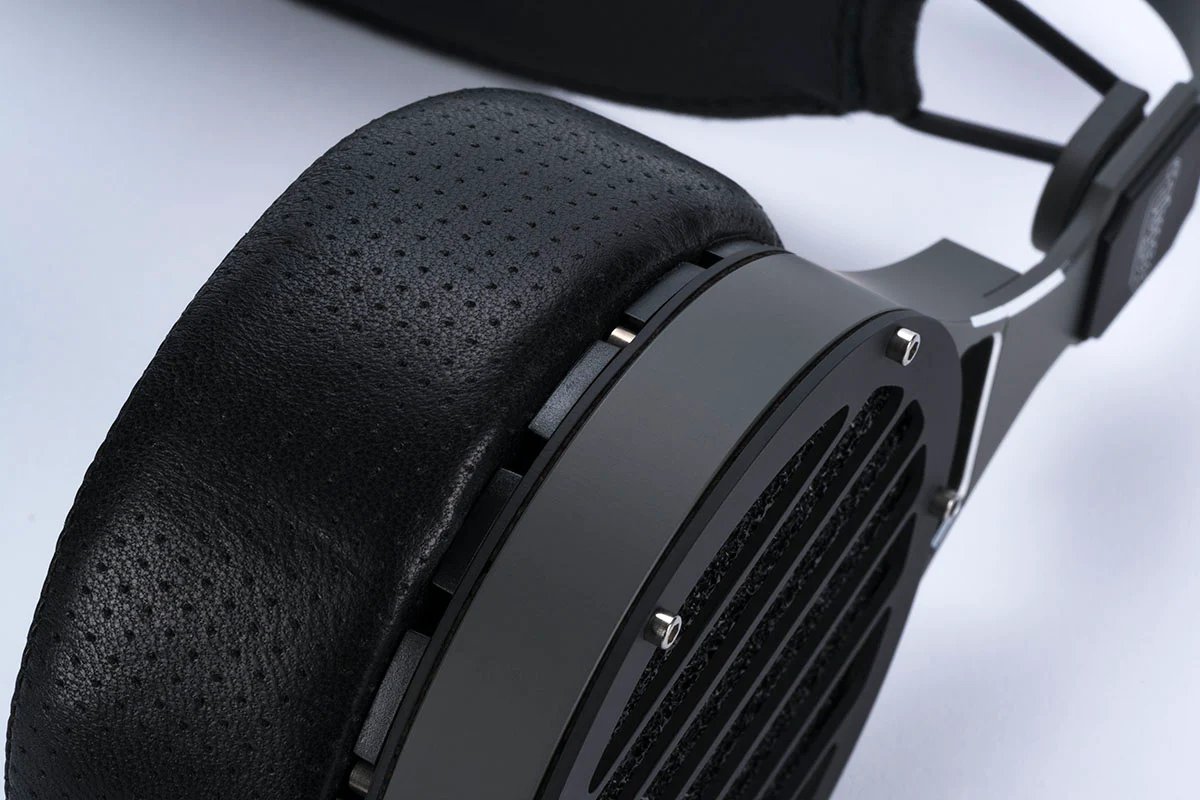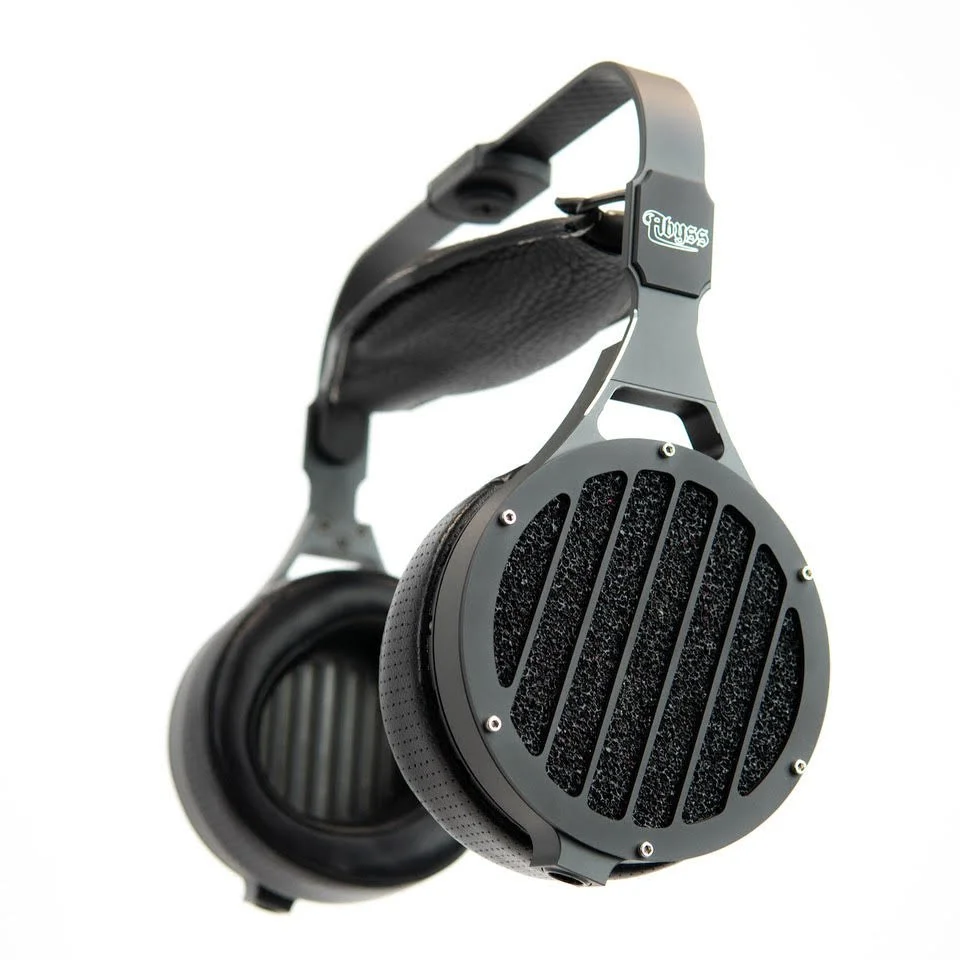ABYSS AB1266 PHI TC - REVIEW
ABYSS AB1266 PHI TC
Not that long ago I discovered the electrostatic headphone world and also that which I had considered unobtainable—“incredible ‘you-are-there’ transparency, deep detail retrieval, and captivating musicality.” In the dress of an electrostatic headphone, the unobtainable had been attained. Technology is clearly and rapidly on the move as attested to by my review of the ZMF Atrium, itself a citizen of three headphone worlds—planar, dynamic, and inclusive of electrostatic. Huzzah!
Nearly nine months later there is yet further evidence of a consilience—act of concurring; coincidence; concurrence—between headphone worlds as embodied by the Abyss AB1266 Phi TC ($5995–$8995). In this case, the bridging of the three distinct worlds by the Abyss AB1266 is even more compelling. The Abyss, it seems, has transcended every headphone save one, to date, across these worlds, that one being the STAX SR-X9000 ($6200). Yet, the two are only separated by the smallest of margins and pluses and minuses, here and there, that find them entirely on an equal footing. More on this later.
Transparency, resolution and detail seemed like pale descriptors for the STAX X9000 relative to the competition. Not really up to the task when attempting to describe what the STAX X9000 was capable of and how profoundly it “handled things”. The same now holds true for the AB1266 Phi TC as, relative to the competition, it is transcendent in most if not all respects.
Why? Because to complete a listening session with the Abyss AB1266 Phi TC and then to attempt to listen through any other headphone, ANY other headphone, regardless of the upstream components, seems, well, futile. As in, “We are the Borg and ‘your music-loving consciousness’ will be assimilated and undeterred. Resistance is futile.” Or, in this case, you are spellbound, completely captured by the music of the Abyss AB1266 Phi TC, and the spell is not to be dispelled by any other headphone. That is to say that a palette cleanser will be in order, lest the next headphone should sound closed-in, dark, entirely unimaginative, when, in fact, it isn’t.
And let me state for the record that the five headphones currently in the AKR’s TOP FIVE HEADPHONES list are to a one exceptional! Exceptional in how they weave transparency, resolution, detail and musicality together, seamlessly, song after song after song. The Abyss AB1266 Phi TC, however, is on another level altogether, and this is amazing. I did not expect this level of differentiation, or to put it another way, such a commanding gap in performance between it and all others. But there it is.
Toward the end of last year I proclaimed the STAX SR-X9000, and I paraphrase, the “best electrostatic headphone in the world”. This was owing to the fact that electrostatics or the technology behind them make them, altogether, without peer. That said and as mentioned above, technology has not stood still. The top planar and dynamic headphones have, indeed, bridged the gap. And now the Abyss AB1266 Phi TC makes its presence known and dramatically so.
REFRAIN: Unlike most reviews, this review will be non-sequential, as it will start with how the headphones actually sound and not the process of physically “undressing” them and/or laying out their various parts, specifications, etc. Think of this review then, as a non-linear movie— In the Shadow of the Moon, Kill Bill, Pulp Fiction, The Queen’s Gambit, etc—that, likewise, starts at the end and winds its way to the beginning.
The Sound
Quiet. Effortless. Pristine. Sublime. Stunning. There are several things that immediately place the Abyss AB1266 Phi TC apart from all headphone contenders and one of those things is its preternatural quiet. The quiet before a band member comes in, before the next pondered word is spoken or sung, during the transition from an interlude, etc. And it, the quiet, begs anticipation and a wanting, like I’ve never quite experienced before. This is just one of the Abyss AB1266 Phi TC’s many talents. The others are its openness and speed, its electrostatic transparency and resolution, its coherency, and its capacious soundstage.
The AB1266 unfolds the music effortlessly and with a pristine, crystal clarity that is neither cold, nor warm, it simply is. And in this sense the music is revealed in all of its glory or lack thereof, should the recording in question be poor. But even the poor recording will be transparently unveiled, revealed like it never has been before. And this is a magic which escapes all others, save the STAX SR-X9000 headphone.
But therein lies the dichotomy of the AB1266, because it is also sweetly sublime in how it engages both sides of one’s brain—the meticulous, detail hungry, bandwidth fastidious listener and also the lover of tone, timbre, texture, the passionate musicophile who needs simply to be moved. And its ability to render a range of tonal shadings/colors is superb. This the Abyss AB1266 does exceedingly well and one is advised to listen/audition only if the price of admission will not call forth pre-stroke tremors or rapid onset catatonia or worse.
The Abyss AB1266 Phi TC will not, however, suffer the weak, watt-ailed, wannabe, headphone amps that cannot measure up or dance or drive it. Understand, this will not be its failing, but that of the watt-less culprit(s) in question. I was very fortunate to have on hand headphone amps ranging in wattage from 2-Watts to 6-Watts and each—Aurorasound HEADA, LTA Z10e, HeadAmp GS-X Mini, HeadAmp GS-X Mk II—danced and sang beautifully with the Abyss AB1266, across all chosen genres.
I had initially quoted for the STAX SR-X9000 review what I had written for the STAX SR-009S review, the once former flagship: “The SR-009S is as transparent as a summer’s day is long—unrivalled transparency… and without peer.” I subsequently said for the SR-X9000, “Scratch that.” The SR-X9000 was by far superior. Well, you’ll need to “scratch that” again as the Abyss AB1266 Phi TC may well be the separated-at-birth-twin which is on a par with the SR-X9000 electrostatic headphone. It is saying a great deal when a planar headphone can match an electrostatic headphone at its formerly undisputed primary gifts.
The Abyss AB1266 Phi TC soundstage is cavernous, middling, and intimate when called on to be so. The question will, nonetheless, arise, “How deep a soundstage can the AB1266 headphone recreate?” The answer direct from the Abyss AB1266—“Bring on the soundstage and I’ll cover it.” And so it did. Yeah, sounds like hyperbole, right? Well, it isn’t and this was but one of the many mind-boggling talents that this planar headphone, as the synthesis or consilience of electrostatic, dynamic, and planar headphones, was capable of. In truth, I didn’t believe all that had been written and said about the Abyss AB1266 Phi TC. I believe it now. Separation of performers across the stage and at depth—layering—and rock-solid positioning, absolutely phenomenal. I’m sure you can see where this is going.
The Abyss AB1266 Phi TC was paired with the AURORASOUND HEADA HPA (review coming), LTA Z10e integrated/headphone amplifier (award winner), the HeadAmp GS-X Mini HPA (award winner), and the HeadAmp GS-X MK II (review coming). The DACs used were the Mola Mola Tambaqui DAC (award winner), the Bricasti Design M1SE (award winner), and the DENAFRIPS Terminator II DAC (award winner). The streamers were the Aurender N30SA (review coming) and Grimm Audio MU1 (award winner). An Audience Front Row Cable suite (award winner) and RSX Beyond and Max power cords (reviews coming) were tasked with wire/cable responsibilities. And an Adept Response aR6-T4 (review coming) provided the power conditioning/regeneration.
Bass
Detailed. Tight. Blistering. Best (as in good, better, best). There was some trepidation, I must admit, to the Aurorasound HEADA driving the Abyss AB1266 with its 2 watts of power. The Abyss at 88db is not at all very efficient and its 50 Ohm impedance requires a good deal of power run across it. So, I began easily, though I had HeadAmps GX-S Mini (4 watts), GS-X Mk II (6 watts) and the LT Z10e (3 watts) to choose from, should things go ‘south’. I began with Dave Holland’s “B-40/M23-6K/RS-W” (Emerald Tears, ECM) as a first demonstration of dexterity, speed, inner detail, and tonal/timbral shading. In brief, it was an electrostatic rendering—speed, transparency, resolution, copious inner detail—with top to bottom planar weight that rendered tight, fast bass. Marcus Miller’s Power (M2, Concord) then rolled in and most fears were quickly put aside, as the HEADA’s 2 watts ‘got down(!)’ with the Abyss AB1266. Nary a clip was heard all through the night. The true test—Eiji Oue’s V. Infernal Dance of King Kashchey (Stravinsky, Reference Recording) was next up. As it cued, ominously, all senses were alert for the faintest trace of clipping. Yet, powerful and thunderous was the opening with the massed tympani (7) and, again, nary a trace of clipping. What there was, in fact, was a beautifully rendered movement replete with excitement, repeated sub-bass dives and unperturbed, lightning-fast, dynamic shifts. If it could be so with the HEADA’s 2 watts all others need not fear. And suffice to say, their performances with the Abyss AB1266 were ‘over the moon’ and, in a number of cases, more potent, but none were truly more musical than the HEADA. Repeat.
Midrange
Detailed. The birds. The birds. Sumptuous beauty. Some touchstones reflect directly on the music of the natural world or, in this case, the birds that sing from a distance outside of the recording studio. Olafur Arnalds’ “Árbakkinn” (Island Songs, Mercury (Universal France)) opens and again the STAX SR-X9000 is rivaled, with the songs of the birds present from the very beginning, in alignment with poet Einar Georg Einarsson’s recital. And it is a recital with gravitas, texture, and intention, given but a few inches away from you. This—the electrostatic openness, the speed, coherence and transparency—are what betray this planar headphone as something much more than it is, as it provides a ‘you-are-there’ realism and beautifully distinct timbres. Repeat. Did I mention the fervid attention to detail retrieval? Yikes!
It is an odd thing, but I can only now truly enjoy choral and live music when an electrostatic system has been engaged for its replay/rendering. Prior to my exposure to electrostatics, I was just fine with the aforementioned music, which I very much enjoyed, played across all components and systems. I then discovered that there was so much more to the music, in all respects, via electrostatics! Voces8’s “Agnus Dei” (Lux, Decca) queues and there is anticipation, as this is an incredibly beautiful piece of music. It opens and a familiar voice is set free. It soars skyward far above the cage of ‘electronic/transducer’ limitations. This portrayal renders a sky-like openness and airiness and limitless height, that, again, grows beyond all previous incarnations. The venue—St. George’s Church, Chesterton, Cambridge, England—has found its true volume. The Abyss AB1266 Phi TC brings me to the realm of electrostatic reproduction, free of electrostatics, as did the ZMF Atrium, but the Abyss AB1266 Phi TC portrayal is better still. Repeat.
Treble+
Detailed. Soaring. Openness. The needle drops, so to speak, on Dave Brubeck’s Take Five (Time Out, Columbia-Legacy) and there is drive and energy, openness and air to Morello’s cymbals, via the HEADA/Abyss combo that makes things so very much alive. The Abyss AB1266 also brings weight and speed and dimensionality to Morello’s kick drum and across the entire piece, not experienced heretofore. This, in turn, brings, via the Abyss, Eugene Wright’s bass into presence and stark relief as opposed to the distant, bodiless, ghost-like strumming it can often be. Repeat. This—the energy, drive, air, weight—is what one would expect seated at the actual performance. Repeat. It’s that good. After some time spent with Dave and Friends, the Kronos Quartet’s “Aaj Ki Raat”—“Tonight is the Night”—(Kronos Caravan, Nonsuch) is given the nod. And it is as if the stage has expanded in all directions. The various instruments, both exotic—Hindustani tabla, Lebanese nay, Iranian kemancheh—and the not so exotic— violins, viola, cello, triangle—are given life and weight and speed. And the rendered timbral/tonal distinctions, shadings, textures, the freed inner details of the various instruments are superb and beyond previous renditions. The STAX SR-X9000 was also very good at this, which sets the two of them distinctly apart from all others. Bravo, bravo!
The Wrappings and Accessories
The Abyss AB1266 Phi TC comes nested in two outer boxes. The first is the shipping box made of thick corrugated cardboard. The second innermost box is completely white, a nice breakaway from its plain brown container. However, when one folds back the lids, one finds a psychedelic print internal to the box. And therein sits the Abyss AB1266’s box. It is a black cardboard box, through and through. Inside rest the Abyss AB1266 Phi TC headphones in styrofoam braces which cradle each headphone. Additionally, the box holds a balanced headphone cable with a 1/4” adapter, instructions, a large velvet carrying bag, and warranty.
It is a design affair with flashes of utilitarianism, the psychedelic, and that which approaches a more formal design motif, nicely done.
Design—Look, Feel, and Technology
Hmmm. Interesting. The Abyss AB1266 Phi TC, from a design perspective, is the embodiment of science fiction, and perhaps its sub-genre—steampunk. It is reminiscent of the Cybermen of Doctor Who, the long running BBC teleseries of which I have long been a fan. And there are quite a few references to this ‘similarity’ among reviewers of the Abyss. I imagine that they too are big fans of Doctor Who.
I can imagine wearing the Abyss AB1266 Phi TC out of doors and experiencing from passersby great empathy for my congenital ailment or recent car accident, or multi-story fall, etc which requires that I wear this head brace thingy. But little do they know.
The Abyss AB1266 Phi TC is an open-back planar, magnetic headphone that is made of aluminum, “with a high quality polymer ceramic finish, and polished metal parts.” Further, to quote Abyss:
“No plastic parts to break, all components machined from solid aluminum for exceptional strength. Integrated resonance control for minimal added coloration. Proprietary patented planar magnetic transducer design utilizing our very thin, very low mass diaphragm. Effortless dynamics and low level detail retrieval in the bass, mids, and highs with spacious sound outside of your head. A front row listening experience with stunning bass impact no other headphone can provide.”
To hold the Abyss is to be well aware of an extremely well made component that, despite its ‘weight’, I wore for many hours without a single issue. It is, perhaps, one of the most comfortable headphones that I have worn. The Abyss AB1266 is a heirloom audio component to be passed on to the next music lover/audiophile in one’s lineage. And though a bit ungainly, in terms of looks, it will, nonetheless, inspire great confidence when listening. Though it’s probably best not to wear it outside or among family or friends.
Technology and Specification
Abyss AB1266 Phi TC
Transducer Type: Patented proprietary planar magnetic
Style: Open
Frequency Response: 5 Hz to 30 KHz
Distortion: Less than 0.2% 20-20KHz, average less than 0.035%
Sensitivity: 88 dB/mW
Impedance: 50 ohms nominal
Weight: 640 grams
Drivability
The Abyss AB1266 Phi TC requires power—a minimum of, perhaps, 2 watts—from a top-tier headphone amplifier to attain its well-noted and stellar performance heights. Anything less and a disservice is done all the way around. I would not recommend a Digital Audio Player (DAP) of any kind, nor would I recommend a low watt desktop headphone amplifier. You see the Achilles heal of AB1266 Phi TC is power/wattage. The lack thereof and things will go south very quickly.
Should the Abyss AB1266 Phi TC be powered well and with exceptional components—Aurorasound HEADA (2 watts), LTA Z10e (3 watts), the HeadAmp GS-X Mini (4 watts), the HeadAmp GS-X Mk II (6 watts)—all will be quite good.
Conclusion
What happens when transparency is, seemingly, exceeded? Realism? Or, perhaps, seeming realism? This is the conundrum raised by the Abyss AB1266 Phi TC and its easy ability to make the best of the best headphones sound dull and uneventful, while it waxes on clear as a well-made bell or an outstanding opera diva, and as it upends electrostatics. Yikes!
No, I was not prepared for the Abyss AB1266 Phi TC. Why? Ever had a movie built up out of all proportion and it turned out to be, well, supremely disappointing (or horrible!)? First, I didn’t expect the AB1266 to be at all disappointing, but as good as reported? Well, it is that good and even at this price point! It is a herculean effort to let the AB1266 Phi TC go or to even consider doing so.
I think that I’ve said it all. The Abyss AB1266 Phi TC is a phenomenal headphone. It brings an undying passion for musicality and a ferocity for transparency and clarity and detail retrieval, formerly the domain of the best electrostatic headphones. But this planar headphone speaks that language—electrostatic—fluently and well. Its only current rival is the STAX SR-X9000 electrostatic headphone. That they are both similarly priced is rather telling, in the manner that one gets what one pays for. That said, I happily award the Abyss AB1266 Phi TC our highest award—the DIAMOND AWARD for incredible technical/musical excellence. No doubt, to be seen again at 2023 Best of the Year.
Pros: Spectacular transparency, resolution, detail, with a refinement and ease and natural musicality that one would think mutually exclusive and, in this case, be unquestionably wrong. A truly breakthrough product!
Cons: Power is the Achilles Heel of the Abyss AB1266 Phi TC. You’ll need plenty of it and it will need to be very good (see Systems).
THE SYSTEMS
Grimm Audio MU1 Streamer
Mola Mola Tambaqui DAC
LTA Z10e HPA
Audience Front Row—cabling and wires
RSX Power Cords
TORUS RM20—Power Generation
2.
Aurender N30SA Streamer
Bricasti Design M1SE DAC
HeadAmp GS-X Mini
HeadAmp GS-X Mk. II
Audience Front Row—Cabling and Wires
RSX Power Cords
Adept Response aR6-T4—Power Generation
3.
MacBook Pro/Running Roon
Silent Angel Streamer
SilentAngel Power Supply
DENAFRIPS Terminator II DAC
Aurorasound HEADA HPA
Audience Front Row—Cabling and Wires
RSX Power Cords
Adept Response aR6-T4—Power Generation
The Company
ABYSS AB1266 PHI TC ($5995)
JPS Labs LLC
16 Lancaster Pkwy
Lancaster, NY 14086 USA
Phone: +1 716-288-9112
abyss-headphones.com
E-mail:info@Abyss-Headphones.com










